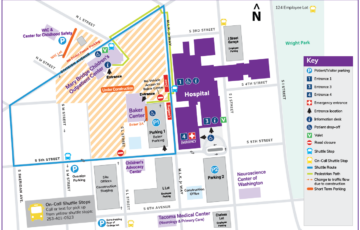
With many families taking local road trips, now is an ideal time to review the updated Washington State car seat laws and read about advances in car seat safety. Motor vehicle crashes are the leading cause of death for children in the United States. However, many of these deaths can be prevented by ensuring children are buckled in the car appropriately and in an age- and size-appropriate car seat or booster seat.
Parents are often looking forward to achieving milestones, including car seat transitions. With car seats, each transition reduces your child’s protection. Parents are encouraged to maximize their child’s safety by using each car seat for as long as the manufacturer’s weight and height guidelines allow.
Using the right car seat can reduce the risk of injury by 71%.
-American Academy of Pediatrics
Changes in the law
Washington State car seat laws changed on January 1, 2020. Washington State’s Child Restraint Laws meet the American Academy of Pediatrics’ evidence-based recommendations for car seat safety.
Here are the important updates to Washington’s Child Restraint Law in 2020:
- Up to age 2: must be properly secured in a rear-facing car seat.
- Ages 2-4: must ride in a car seat with a harness (rear- or forward-facing).
- Age 4 and older: must ride in a car or booster seat until they are 4 ft. 9 in. tall.
- Over 4 ft. 9 in. tall: must be secured by a properly fitted seat belt. This typically occurs at 8-12 years of age.
- Under age 13: children must ride in the back seat when practical to do so.
- Child restraint system must comply with U.S. Department of Transportation standards and be used according to vehicle and child restraint manufacturer.
Frequently asked questions
At what age should I turn my baby’s car seat to be forward facing?
Evidence from studies completed in the U.S. and Sweden provided data that led to the updated child passenger safety recommendations in 2018. Factors in young children’s anatomy that increase the risk of injury in a motor vehicle accident include a larger head size compared to their body size, looser ligaments, and a higher center of gravity. If a vehicle stops suddenly, a rear-facing seat will cradle a child’s back and spread out the force, reducing the risk of serious injury.
Rear facing car seats have been shown to be the safest position when children meet the weight and height guidelines listed by the manufacturer. Most convertible car seats designed for rear-facing have weight limits up to 35-40 lbs. This allows many young children to remain rear-facing in their preschool years if they meet the weight and height guidelines. Make sure to check your car seat manual to determine the maximum height and weight for your car seat as this can vary between manufacturers. Keeping our children rear-facing until age 2 or later reduces the risk of injury.
What if my child’s legs are too long for a rear-facing car seat?
As long as your child does not exceed the maximum height and weight limits for the seat, it is recommended to continue to keep them rear-facing. Despite long legs, rear-facing remains the safest position to best protect their head and neck.
When should my child transition to the next type of seat?
Since each transition reduces the level of protection, you should keep your child in each seat as long as possible. As a general rule, wait until your child meets the maximum height and weight requirements for their particular seat before moving to the next one. Check your car seat manual to find the maximum height and weight requirements for your specific seat.
- Rear-facing: Infants and children should be rear-facing in the back seat from birth until about 2-4 years old—once they meet the maximum height and weight requirements for the seat.
- Forward-facing: After outgrowing their rear-facing seat, your child should remain in a forward-facing car seat until he or she is at least 5 years old.
- Booster: Once your child has met the maximum height and weight requirements for their forward-facing seat, they are ready for a booster seat. They should remain in a booster seat until the seat belt fits properly. The lap belt should lay across the upper thighs (not the stomach) and the shoulder belt should lay across the chest (not the neck). This is typically achieved once the child reaches 4 ft. 9 in. tall. It may be tempting to transition sooner, especially if their friends no longer need a booster seat. However, for your child’s safety, it is important to continue using a booster seat until they meet the height requirement and their seat belt fits correctly.
A 2020 car seat product list with information on rear-facing, forward-facing, and booster seats that follow the Federal Motor Vehicle Safety Standards can be found on the American Academy of Pediatrics website.
The National Highway Traffic Safety Administration (NHTSA) has also put together a car seat Ease-of-Use rating to help families compare car seat features.
When can my child sit in the front seat?
The Centers for Disease Control and the National Highway Traffic Safety Administration recommend keeping children under the age of 13 in the back seat. In the event of a car accident, children can get seriously injured from airbag deployment.
Are there different guidelines if my child has special needs?
There are additional car seat guidelines, last updated by the American Academy of Pediatrics in May 2019, for families with infants and children with special needs. Children with airway abnormalities, developmental delays, orthopedic conditions, muscle tone abnormalities, gastrointestinal disorders, and challenging behaviors may need additional modifications to the car seat for their protection. Premature or low birthweight infants will also be assessed prior to being discharged from the hospital to determine if any additional modifications are needed for their safety in a car seat. For children with special needs, a trained technician in car seat safety will be needed for the evaluation for the safest experience of the child in a vehicle.
Can my infant stay in the car seat after we have arrived at our destination if they are sleeping?
Car seats are a safe way of transporting infants when traveling in a vehicle. If the infant is sleeping when they are no longer traveling, they should be placed in a crib or bassinet. A firm, flat surface is recommended for sleep. The U.S. Consumer Product Safety Commission Injury data estimates greater than 8,000 infants per year are seen in hospital emergency departments in the U.S. for injuries associated with car seats that are outside the vehicle.
What are the local resources to get my car seat checked?
A certified child passenger safety technician can teach families how to use a car seat from the safety of your home. Due to COVID-19, many car seat check locations now offer virtual visits or have made modifications to their car seat clinics.
To find car seat check locations or virtual car seat checks:
- Safe Kids Washington
- National Highway Traffic Safety Administration
- Pierce County: Mary Bridge Center for Childhood Safety offers virtual car seat checks. Email childsafety@multicare.org or call Mary Bridge Center for Childhood Safety at 253-403-1234.
- King County: Seattle Children’s Hospital 206-987-5999
King County Certified Child Passenger Safety Technicians offer virtual appointments via video chat platforms. 206-477-8664. - Kitsap County: Safe Kids Kitsap County/South Kitsap Fire and Rescue inspection station (360) 307-4044
Any additional questions?
Additional information can also be found about Target Zero from the Washington State Department of Transportation.
At Pediatrics Northwest, your child’s safety is our priority. We look forward to discussing car seat safety at each well child visit.
Related Stories


